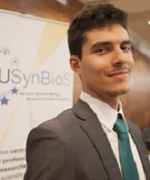Reliable IP-free system for inter-chassis transfer of the high molecular weight DNA
This project aims to develop an IP-free system for transfer of the high molecular weight DNA from E. coli to M. polymorpha. This includes development of the plant-specific iBACs for the reliable transfer and integration of the high molecular weight DNA into the M. polymorpha genome. Alternative methods for interchassis DNA transfer, such as integrative and conjugative elements (ICEs) will be also explored.
The Idea
The ability to manipulate and transfer the high molecular weight DNA molecules between different chassis constitutes one of the main bottlenecks of the rational genome engineering. Bacterium Escherichia coli and plant Marchantia polymorpha are both well-characterized model organisms that are frequently used as chassis for biotechnology and synthetic biology applications. Although the vast majority of the good DNA assembly and editing tools are in E. coli, M. polymorpha is better host for certain applications. Novel tools combining the benefits of M. polymorpha chassis and the reliable DNA recombineering approaches developed for E. coli are critical for developing a robust synthetic biology toolkit. Bacterial artificial chromosomes (BACs) based on the E. coli fertility factor (F-factor) are frequently used for engineering high molecular weight DNA fragments in E. coli. We have recently engineered integrative bacterial artificial chromosomes (iBACs) that can accept virtually any high molecular weight DNA fragment for integration into B. subtilis chromosome and allow rapid selection of transformants by B. subtilis-specific antibiotic resistance and the yellow fluorescent protein (mVenus) expression. This project aims to develop an IP-free system for transfer of the high molecular weight DNA from E. coli to M. polymorpha. This includes development of the plant-specific iBACs for the reliable transfer and integration of the high molecular weight DNA into the M. polymorpha genome. Alternative methods for interchassis DNA transfer, such as integrative and conjugative elements (ICEs) will be also explored.
The Team
Dr. Mario Juhas
Research Associate, Department of Pathology
Dr. Dave Willey
Christian R. Boehm
PhD Candidate in Plant Synthetic Biology, Department of Plant Sciences
Project Outputs
Project Report
Summary of the project's achievements and future plans
Project Proposal
Original proposal and application
Download PDF >>
Project application slides
Design files and documentation
This project led to a number of educational resources and useful DNA parts for the transfer the high molecular weight DNA between synthetic biology chassis - contributing to overcoming a major bottleneck of rational genome engineering.
Outcomes, Outputs and Progress
Bacterial artificial chromosomes (BACs) are frequently used for manipulating high molecular weight DNA fragments in E. coli. To facilitate integration of the high molecular weight DNA into M. polymorpha plastid, we engineered the well-characterized BAC pBeloBAC11 by inserting sequences homologous to the trnG-trnfM intergenic region of the M. polymorpha plastid DNA. Two integration target sequences introduced into pBeloBAC11, the leading (5') integration sequence (mppl1) and the trailing (3') integration sequence (mppl2) are 922 bp and 742 bp long, respectively. Any high molecular weight DNA inserted between the leading and trailing integration sequence will integrate into M. polymorpha by homologous recombination following microprojectile bombardment (biolistic method). Furthermore, the engineered iBAC (iBAC_Mp_mTurq) harbours cyan fluorescent protein-encoding gene (mTurq) and the spectinomycin resistance-encoding gene aadA, located between two flanking mppl integration sequences. The homologous sequences to the trnG-trnfM intergenic region of the M. polymorpha plastid DNA, cyan fluorescent protein-encoding gene (mTurq) and aadA conferring resistance to spectinomycin were obtained from plasmid pCSCL0*b (Boehm et al, Plant Cell Physiol, 2015).
We used Gibson Isothermal Assembly (Gibson et al, Nat Methods, 2009, Merryman and Gibson, Metab Eng, 2012) to assemble iBAC_Mp_mTurq. Briefly, PCR amplified pBeloBAC11 backbone and the gene cassette comprising mTurq and aadA flanked by mppl integration target sites were joined to generate iBAC_Mp_mTurq. E. coli cells harbouring correctly assembled iBAC_Mp_mTurq grew on selective medium containing spectinomycin. The engineering of iBAC_Mp_mTurq was confirmed by diagnostic PCR with the flanking primers and sequencing. The engineered iBAC_Mp_mTurq can accept virtually any high molecular weight DNA for integration into the M. polymorpha plastid.
Follow Up Plans
The iBAC_Mp_mTurq-mediated system for the high molecular weight DNA integration into the M. polymorpha plastid allows rapid selection of transformants by spectinomycin resistance and the cyan fluorescent protein, mTurquoise, expression. In the follow up work we would like to adapt this system for expression of 17 different fluorescent proteins and chromoproteins. These fluorescent proteins and chromoproteins will be engineered for maximal expression in the M. polymorpha plastid.






